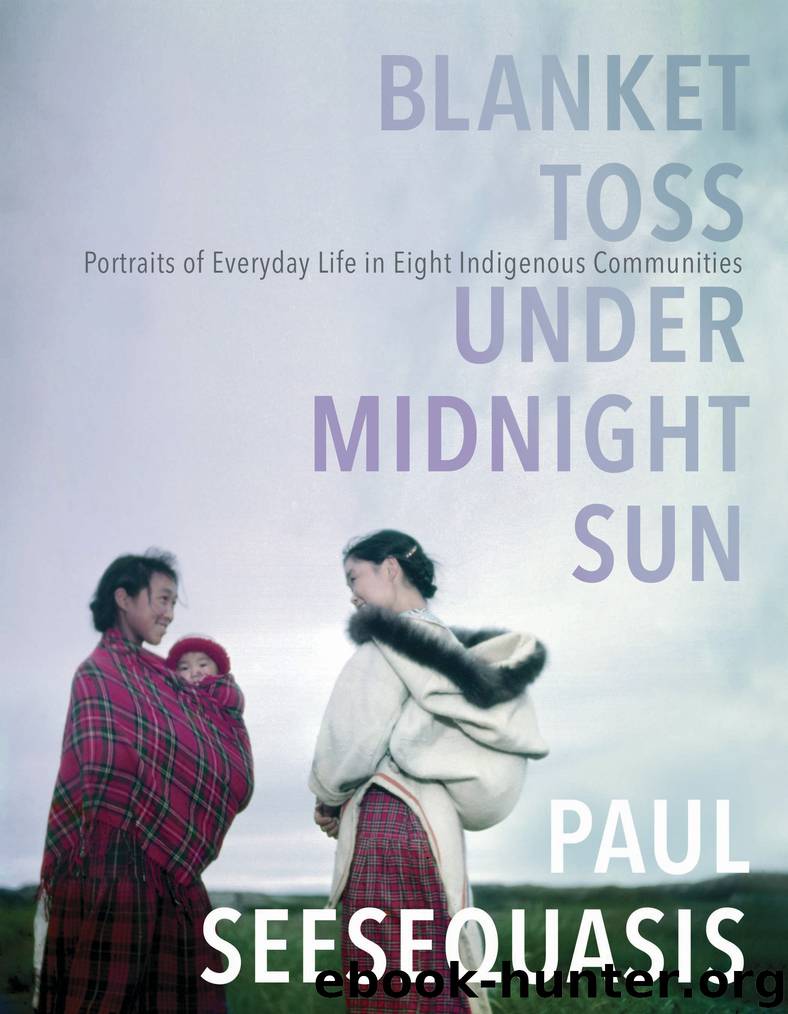Blanket Toss Under Midnight Sun by Paul Seesequasis

Author:Paul Seesequasis
Language: eng
Format: epub
Publisher: Knopf Canada
Published: 2019-10-21T16:00:00+00:00
FAIRS IN NEIGHBOURING TOWNS AND CITIES were a big deal for Indigenous people on the Prairies in the 1940s and ’50s. It was a chance to hitch up the wagon, load the whole family, along with items to sell or trade, and head into town. At a time when the Indian agent still controlled much of reserve life, and the pass system, designed to keep “Indians on the reserve,” was enforced, the chance to travel off-reserve was very welcome.
Events like the North Battleford fair attracted wagonloads of families from neighbouring reserves. In the Battleford area, mostly Cree, Dakota, and Metis came to the fairs to trade and buy goods, see the attractions, and, most importantly, socialize with relatives and friends and catch up on happenings at a time when the dominant mode of communication was still word of mouth.
This photograph was taken the day after the fair. The teams of horses are now hitched up; people, dressed in their Sunday best, are saying their final goodbyes to relations and friends from neighbouring reserves, making last-minute exchanges of goods and preparing for the long journey “back to the rez.” These fair get-togethers also echo the old times, when smaller bands would come together during the warm months, at special places, for ceremonies, trading and dancing.
One of these gathering places was the valley of the Opimihaw Creek, near Saskatoon, where the creek feeds into the South Saskatchewan River. Recent archaeological digs have found stone cairns, pottery fragments, tipi rings, tools, eggshell fragments, arrowheads and animal bones that predate the building of the Egyptian pyramids. The Wolf Willow dig at Wanuskewin has found artifacts that date back about five thousand years, including a five-hundred-year-old, highly polished elk tooth that was part of a beautiful amulet worn by a woman.
Before the first horses arrived on the Plains, Wanuskewin was the site of buffalo jumps, which were a meticulously planned stampeding and funnelling of bison over the steep slopes of the Opimihaw valley. A successful hunt would feed and clothe a tribe for the year. Once horses arrived on the northern Plains in the early 1700s, the days of the buffalo jump ended, as the Plains tribes quickly adopted the horse, but places like Wanuskewin remained annual gathering places where bands came together in the summer and held both social and ceremonial celebrations.
Everett Baker’s photograph of the North Battleford fair in 1945 shows that the desire of the people to congregate, trade and celebrate together was not extinguished, even after seventy years of living under the reserve system, and dealing with the restrictive bureaucracy of the Indian Act and the Indian agent.
Download
This site does not store any files on its server. We only index and link to content provided by other sites. Please contact the content providers to delete copyright contents if any and email us, we'll remove relevant links or contents immediately.
| Celebrations & Events | Lifestyle |
| Street Photography | Weddings |
Shoot Sexy by Ryan Armbrust(17142)
Portrait Mastery in Black & White: Learn the Signature Style of a Legendary Photographer by Tim Kelly(16484)
Adobe Camera Raw For Digital Photographers Only by Rob Sheppard(16387)
Photographically Speaking: A Deeper Look at Creating Stronger Images (Eva Spring's Library) by David duChemin(16161)
Bombshells: Glamour Girls of a Lifetime by Sullivan Steve(13108)
Art Nude Photography Explained: How to Photograph and Understand Great Art Nude Images by Simon Walden(12348)
Perfect Rhythm by Jae(4621)
Pillow Thoughts by Courtney Peppernell(3397)
The Book of Joy by Dalai Lama(3217)
Good by S. Walden(2915)
The Pixar Touch by David A. Price(2739)
Fantastic Beasts: The Crimes of Grindelwald by J. K. Rowling(2543)
A Dictionary of Sociology by Unknown(2518)
Humans of New York by Brandon Stanton(2379)
Read This If You Want to Take Great Photographs by Carroll Henry(2303)
Stacked Decks by The Rotenberg Collection(2270)
On Photography by Susan Sontag(2130)
Photographic Guide to the Birds of Indonesia by Strange Morten;(2088)
Insomniac City by Bill Hayes(2084)
